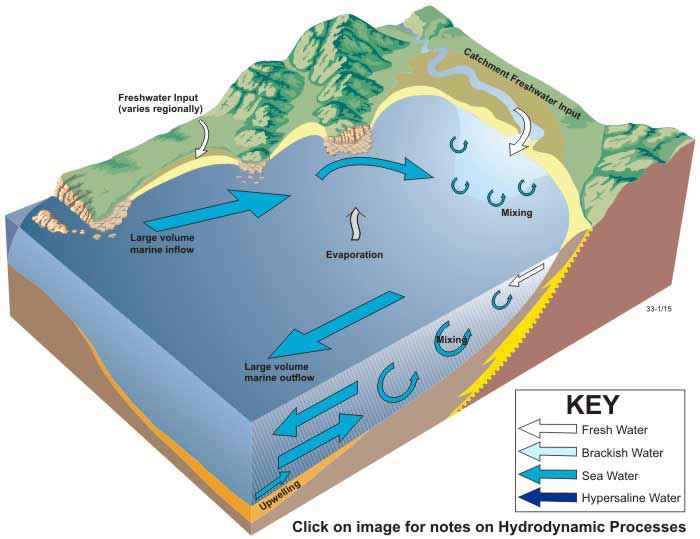
Hydrology processes in embayments and drowned river valleys
1. Catchment freshwater input
Freshwater input from the catchment varies considerably, ranging from intermittent or no flow, to large-volume continuous flows, depending on local catchment and climate conditions. Inputs may occur at a single, or multiple locations, and these sites are often considered as separate estuaries or coastal waterways in their own right.
2. Mixing of fresh and marine water
The volume of freshwater entering the embayment is low relative to the total volume of water in the embayment. Stratification is thus less pronounced (Yassini et al., 1995). Mixing between fresh and salt water occurs rapidly, depending on the activity of currents (Holloway et al., 1991). The large water area typical of embayments tends to buffer and reduce the impact of floods upon the flanking environments of embayments (Roy et al., 2001).
3. Internal currents
Due to the coriolis force, flood and ebb tidal streams may have different routes into and out of large embayments, creating a gyre-like circulation pattern (Holloway et al., 1991). This effect is more apparent at higher latitudes. Additionally, tidal range amplification can occur in funnel-shaped drowned river valleys (Dalrymple et al., 1992). Wind-induced currents, in combination with tidal influx, and the coriolis force, are the principal controls on the strength of water circulation within the embayment.
4. Large volume of marine inflow and outflow
Due to a wide, unconstricted entrance and large tidal prism, the exchange of water between the embayment and the ocean dominates hydrological processes. Embayments are thus ‘seawater dominated’ (Heggie et al., 1999b). Marine ‘flushing’ depends on the amount of freshwater advection, and the extent of oscillatory water movement (and other mixing processes). Upwelling of water from the inner continental shelf may also be important. Marine conditions and salinity prevail (Yassini et al., 1995).
5. Evaporation
Despite the large surface area, evaporation over the entire embayment is a relatively minor process due to typically large volume and rapid marine flushing.


